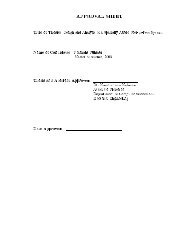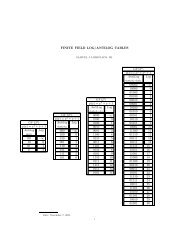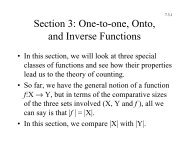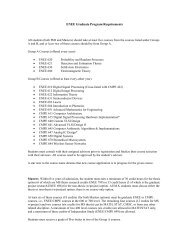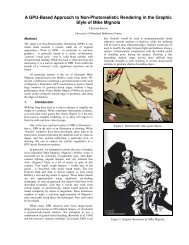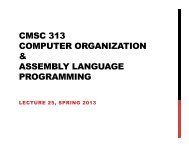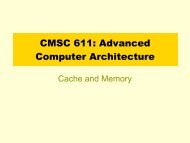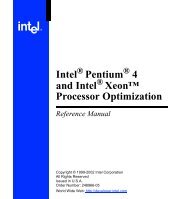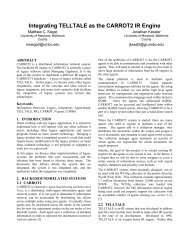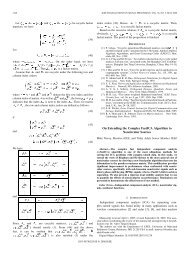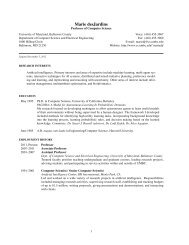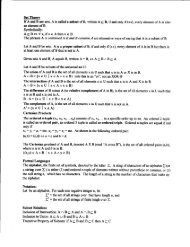CMSC 611: Advanced Computer Architecture
CMSC 611: Advanced Computer Architecture
CMSC 611: Advanced Computer Architecture
You also want an ePaper? Increase the reach of your titles
YUMPU automatically turns print PDFs into web optimized ePapers that Google loves.
<strong>CMSC</strong> <strong>611</strong>: <strong>Advanced</strong><br />
<strong>Computer</strong> <strong>Architecture</strong><br />
Cache
Processor<br />
Control<br />
Datapath<br />
Introduction<br />
• Why do designers need to know about Memory technology?<br />
– Processor performance is usually limited by memory bandwidth<br />
– As IC densities increase, lots of memory will fit on chip<br />
• What are the different types of memory?<br />
• How to maximize memory performance with least cost?<br />
<strong>Computer</strong><br />
Memory<br />
Devices<br />
Input<br />
Output
Performance<br />
1000<br />
100<br />
10<br />
1<br />
Processor-Memory<br />
Performance<br />
CPU-DRAM Gap“Moore’s Law”<br />
1980<br />
1981<br />
1982<br />
1983<br />
1984<br />
1985<br />
1986<br />
1987<br />
1988<br />
1989<br />
1990<br />
1991<br />
1992<br />
1993<br />
1994<br />
1995<br />
1996<br />
1997<br />
1998<br />
1999<br />
2000<br />
Time<br />
CPU<br />
DRAM<br />
µProc<br />
60%/yr.<br />
(2X/1.5yr)<br />
Processor-Memory<br />
Performance Gap:<br />
(grows 50% / year)<br />
Problem: Memory can be a bottleneck for processor performance<br />
DRAM<br />
9%/yr.<br />
(2X/10 yrs)<br />
Solution: Rely on memory hierarchy of faster memory to bridge the gap
Datapath<br />
Speed:<br />
Size:<br />
Cost:<br />
Processor<br />
Control<br />
Memory Hierarchy<br />
• Temporal Locality (Locality in Time):<br />
fi Keep most recently accessed data items closer to the processor<br />
• Spatial Locality (Locality in Space):<br />
fi Move blocks consists of contiguous words to the faster levels<br />
Registers<br />
On-Chip<br />
Cache<br />
Second<br />
Level<br />
Cache<br />
(SRAM)<br />
Main<br />
Memory<br />
(DRAM)<br />
Secondary<br />
Storage<br />
(Disk)<br />
Compiler<br />
Fastest<br />
Smallest<br />
Hardware<br />
Operating<br />
System<br />
Slowest<br />
Biggest<br />
Highest Lowest
To Processor<br />
From Processor<br />
Memory Hierarchy<br />
Terminology<br />
• Hit: data appears in some block in the faster level (example: Block X)<br />
– Hit Rate: the fraction of memory access found in the faster level<br />
– Hit Time: Time to access the faster level which consists of<br />
• Memory access time + Time to determine hit/miss<br />
• Miss: data needs to be retrieve from a block in the slower level (Block Y)<br />
– Miss Rate = 1 - (Hit Rate)<br />
– Miss Penalty: Time to replace a block in the upper level + Time to<br />
deliver the block the processor<br />
• Hit Time
Memory Hierarchy Design<br />
Issues<br />
• Block identification<br />
– How is a block found if it is in the upper (faster) level?<br />
• Tag/Block<br />
• Block placement<br />
– Where can a block be placed in the upper (faster) level?<br />
• Fully Associative, Set Associative, Direct Mapped<br />
• Block replacement<br />
– Which block should be replaced on a miss?<br />
• Random, LRU<br />
• Write strategy<br />
– What happens on a write?<br />
• Write Back or Write Through (with Write Buffer)<br />
Slide: Dave Patterson
Requesting X n<br />
generates a miss and<br />
the word X n will be<br />
brought from main<br />
memory to cache<br />
Issues:<br />
The Basics of Cache<br />
• Cache: level of hierarchy closest to processor<br />
• Caches first appeared in research machines in early 1960s<br />
• Virtually every general-purpose computer produced today<br />
includes cache<br />
X4<br />
X1<br />
Xn – 2<br />
Xn – 1<br />
X3<br />
a. Before the reference to Xn<br />
• How do we know that a data item is in cache?<br />
• If so, How to find it?<br />
X2<br />
X4<br />
X1<br />
Xn – 2<br />
Xn – 1<br />
X2<br />
Xn<br />
X3<br />
b. After the reference to Xn
Valid Bit<br />
Cache Tag<br />
• Worst case is to keep replacing<br />
a block followed by a miss for it:<br />
Ping Pong Effect<br />
• To reduces misses:<br />
Direct-Mapped Cache<br />
– make the cache size bigger<br />
– multiple entries for the same<br />
Cache Index<br />
Cache<br />
Cache Data<br />
Byte 3<br />
Byte 2<br />
Byte 1<br />
Byte 0<br />
Memory words can be<br />
mapped only to one<br />
cache block<br />
00001 00101 01001 01101 10001 10101 11001 11101<br />
Memory<br />
Cache block address = (Block address) modulo (Number of cache blocks)
# cache<br />
blocks<br />
Tag<br />
Accessing Cache<br />
• Cache Size depends on:<br />
– # cache blocks<br />
– # address bits<br />
– Word size<br />
• Example:<br />
– For n-bit address, 4-byte<br />
word & 1024 cache<br />
blocks:<br />
– cache size =<br />
1024 [(n-10 -2) + 1 + 32] bit<br />
Valid bit<br />
Word<br />
size<br />
Address (showing bit positions)<br />
Byte<br />
offset<br />
20 10<br />
Hit Data<br />
Tag<br />
Index<br />
0<br />
1<br />
2<br />
1021<br />
1022<br />
1023<br />
31 30 13 12 11 2 1 0<br />
Index<br />
Valid Tag Data<br />
20 32
Cache with Multi-Word/Block<br />
Address (showing bit positions)<br />
16 12 2 Byte<br />
Hit<br />
Tag<br />
Data<br />
offset<br />
16 bits 128 bits<br />
V Tag Data<br />
16 32<br />
31 16 15 4 32 1 0<br />
Index<br />
32 32 32<br />
Mux<br />
32<br />
Block offset<br />
4K<br />
entries<br />
• Takes advantage of spatial locality to improve performance<br />
• Cache block address = (Block address) modulo (Number of cache<br />
blocks)<br />
• Block address = (byte address) / (bytes per block)
Miss<br />
Penalty<br />
Determining Block Size<br />
• Larger block size take advantage of spatial locality BUT:<br />
– Larger block size means larger miss penalty:<br />
• Takes longer time to fill up the block<br />
– If block size is too big relative to cache size, miss rate will go up<br />
• Too few cache blocks<br />
• Average Access Time =<br />
Hit Time * (1 - Miss Rate) + Miss Penalty * Miss Rate<br />
Block Size<br />
Miss<br />
Rate Exploits Spatial Locality<br />
Fewer blocks:<br />
compromises<br />
temporal locality<br />
Block Size<br />
Average<br />
Access<br />
Time<br />
Increased Miss Penalty<br />
& Miss Rate<br />
Block Size<br />
Slide: Dave Patterson
Block # 0 1 2 3 4 5 6 7<br />
Data<br />
Tag<br />
Search<br />
Direct mapped<br />
1<br />
2<br />
Block Placement<br />
Set # 0 1 2 3<br />
Data<br />
Tag<br />
Search<br />
Set associative<br />
1<br />
2<br />
Data<br />
Tag<br />
Search<br />
Hardware Complexity<br />
Cache utilization<br />
Fully associative<br />
• Set number = (Block number) modulo (Number of sets in the cache)<br />
• Increased flexibility of block placement reduces probability of cache misses<br />
1<br />
2
31<br />
X<br />
X<br />
X<br />
Fully Associative Cache<br />
• Forget about the Cache Index<br />
• Compare the Cache Tags of all cache entries in parallel<br />
• Example: Block Size = 32 Byte blocks, we need N 27-bit comparators<br />
• By definition: Conflict Miss = 0 for a fully associative cache<br />
X<br />
X<br />
Cache Tag<br />
Cache Tag (27 bits long)<br />
:<br />
Valid Bit<br />
:<br />
4<br />
Cache Data<br />
Byte 31 :<br />
Byte 63 :<br />
Byte Select<br />
Ex: 0x01<br />
Byte 1<br />
Byte 33<br />
:<br />
0<br />
Byte 0<br />
Byte 32<br />
Slide: Dave Patterson
Valid<br />
N-way Set Associative Cache<br />
• N entries for each Cache Index<br />
• Example: Two-way set associative cache<br />
– Data is selected based on the tag result<br />
Cache Index<br />
Cache Tag Cache Data<br />
Cache Data<br />
Cache Block 0<br />
: :<br />
:<br />
Adr Tag<br />
– Cache Index selects a “set” from the cache<br />
– The two tags in the set are compared in parallel<br />
Compare<br />
Sel1<br />
1<br />
Mux<br />
0<br />
Sel0<br />
OR<br />
Cache Block 0<br />
:<br />
Cache Block<br />
Cache Tag Valid<br />
Compare<br />
: :<br />
Hit Slide: Dave Patterson
Index<br />
Tag size increases with<br />
higher level of associativity<br />
0<br />
1<br />
2<br />
253<br />
254<br />
255<br />
Locating a Block in<br />
Associative Cache<br />
Address<br />
V Tag<br />
31 30 12 11 10 9 8 3 2 1 0<br />
22 8<br />
Data V Tag Data V Tag Data V Tag Data<br />
4-to-1 multiplexor<br />
Hit Data<br />
22<br />
32
Handling Cache Misses<br />
• Misses for read access always bring blocks from main memory<br />
• Write access requires careful maintenance of consistency between<br />
cache and main memory<br />
• Two possible strategies for handling write access misses:<br />
– Write through: The information is written to both the block in the cache and to<br />
the block in the slower memory<br />
• Read misses cannot result in writes<br />
• No allocation of a cache block is needed<br />
• Always combined with write buffers so that don’t wait for slow memory<br />
– Write back: The information is written only to the block in the cache. The<br />
modified cache block is written to main memory only when it is replaced<br />
• Is block clean or dirty?<br />
• No writes to slow memory for repeated write accesses<br />
• Requires allocation of a cache block
Write Through via Buffering<br />
Processor<br />
Cache<br />
Write Buffer<br />
• Processor writes data into the cache and the write buffer<br />
• Memory controller writes contents of the buffer to memory<br />
DRAM<br />
• Increased write frequency can cause saturation of write buffer<br />
• If CPU cycle time too fast and/or too many store instructions in a row:<br />
– Store buffer will overflow no matter how big you make it<br />
– The CPU Cycle Time get closer to DRAM Write Cycle Time<br />
• Write buffer saturation can be handled by installing a second level (L2) cache<br />
Processor<br />
Cache<br />
Write Buffer<br />
L2<br />
Cache<br />
DRAM<br />
Slide: Dave Patterson
Block Replacement Strategy<br />
• Straight forward for Direct Mapped since every block has only one<br />
location<br />
• Set Associative or Fully Associative:<br />
– Random: pick any block<br />
– LRU (Least Recently Used)<br />
• requires tracking block reference<br />
• for two-way set associative cache, reference bit attached to every block<br />
• more complex hardware is needed for higher level of cache associativity<br />
Associativity<br />
2-way 4-way 8-way<br />
Size<br />
LRU Random LRU Random LRU Random<br />
16 KB 5.2% 5.7% 4.7% 5.3% 4.4% 5.0%<br />
64 KB 1.9% 2.0% 1.5% 1.7% 1.4% 1.5%<br />
256 KB 1.15% 1.17% 1.13% 1.13% 1.12% 1.12%<br />
• Empirical results indicates less significance of replacement strategy with<br />
increased cache sizes<br />
Slide: Dave Patterson
Measuring Cache Performance<br />
• To enhance cache performance, one can:<br />
– reduce the miss rate (e.g. diminishing blocks collision<br />
probability)<br />
– reduce the miss penalty (e.g. adding multi-level caching)<br />
– Enhance hit access time (e.g. simple and small cache)<br />
CPU time = (CPU execution clock cycles + Memory -stall clock cycles) ¥ Clock cycle time<br />
Memory - stall clock cycles = Read-<br />
stall cycles + Write - stall cycles<br />
Read<br />
Read - stall cycles = ¥ Read miss rate ¥<br />
Program<br />
For write-through scheme:<br />
Read miss penalty<br />
Hard to control, assume<br />
enough buffer size<br />
Ê Write<br />
ˆ<br />
Write - stall cycles = Á ¥ Write miss rate ¥ Write miss penalty˜<br />
+ Write buffer<br />
Ë Program<br />
¯<br />
stalls
Example<br />
Assume an instruction cache miss rate for gcc of 2% and a data cache miss rate of 4%.<br />
If a machine has a CPI of 2 without any memory stalls and the miss penalty is 40 cycles<br />
for all misses, determine how much faster a machine would run with a perfect cache that<br />
never missed. Assume 36% combined frequencies for load and store instructions<br />
Answer:<br />
Assume number of instructions = I<br />
The number of memory miss cycles = I ¥ 2% ¥ 40 = 0.8 ¥ I<br />
Data miss cycles = I ¥ 36% ¥ 4% ¥ 40 = 0.56 ¥ I<br />
Total number of memory-stall cycles = 0.8 I + 0.56 I = 1.36 I<br />
The CPI with memory stalls = 2 + 1.36 = 3.36<br />
CPU time with stalls I¥<br />
CPIstall<br />
¥ Clock cycle CPIstall<br />
3.<br />
36<br />
=<br />
= =<br />
CPU time with perfect cache I¥<br />
CPI ¥ Clock cycle CPI 2<br />
perfect<br />
What happen if CPU gets faster?<br />
perfect
Multi-level Cache Performance<br />
Suppose we have a 500 MHz processor with a base CPI of 1.0 with no cache misses.<br />
Assume memory access time is 200 ns and average cache miss rate is 5%. Compare<br />
performance after adding a second level cache, with access time 20 ns, that reduces<br />
miss rate to main memory to 2%.<br />
Answer:<br />
The miss penalty to main memory = 200/cycle time<br />
= 200 ¥ 500/1000 = 100 clock cycles<br />
Effective CPI = Base CPI + memory-stall cycles/instr. = 1 + 5% ¥ 100 = 6.0<br />
With two-level caches<br />
The miss penalty for accessing 2 nd cache = 20 ¥ 500/1000 = 10 clock cycles<br />
Total CPI = Base CPI + main memory-stall cycles/instruction +<br />
secondary cache stall cycles/instruction<br />
= 1 + 2% ¥ 100 + 5% ¥ 10 = 3.5



